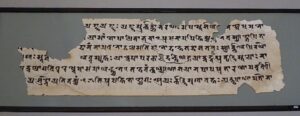Witness the stories that manuscripts tell at ‘Evam Vadati Pustakam’

AMHiTA Exhibition 4 AstasahasrikaPrajñāpāramitāhṛdayaPala
Team L&M
An exhibition of a selected digitised South Asian manuscripts sourced from national and international repositories, Evam Vadati Pustakam, begins tomorrow at IIC, New Delhi. The show traces the journey of texts across languages and to different parts of Asia, and stories of how manuscripts were collected down the ages. The exhibits illustrate what manuscripts can tell us about their authors, the process of composition, and the worlds of their readers. The exhibition will be inaugurated by Minister for External Affairs Dr S Jaishankar at 6:30pm.
The exhibition forms a part of SAMHiTA (Sanskrit for ‘compilation’ or ‘collection’), or South Asian Manuscript Histories and Textual Archive, an initiative of the IIC supported by the Ministry of External Affairs to create a database of South Asian manuscripts in institutions outside India.
South Asia has been a melting pot of cultures and civilisations for centuries now. The exchange of ideas and knowledge systems from as early as the 2nd-3rd centuries CE have been preserved in handwritten manuscripts, crafted out of palm leaf, birch bark, or handmade paper. These historical records show us how texts connected different regions, linking disciplines, and the processes of synthesis through which knowledge evolved. This is a heritage that represents a diverse literature that goes beyond what we view as separate disciplines today, such as medicine, mathematics, linguistic science, and metaphysics.
Sometimes, manuscripts might be objects of veneration, or serve as guides to practice, including the meditative contemplation of deities. There are theoretical treatises and practical manuals on applied sciences like architecture and agriculture, and literature on aesthetic theory and the performing arts; biographies of rulers, sants and Sufis; histories of individuals and dynasties; an array of imaginative literature; texts on games, on love-making, and on culinary matters including alcohol.
This exhibition is an ode to the artistry of the scribes, painters and binders who handcrafted these texts with great care; the patrons of authors and translators who facilitated the transmission of knowledge and made the texts more accessible; and scholars who studied the manuscripts and restored legacies dispersed over time.
On till September 28




